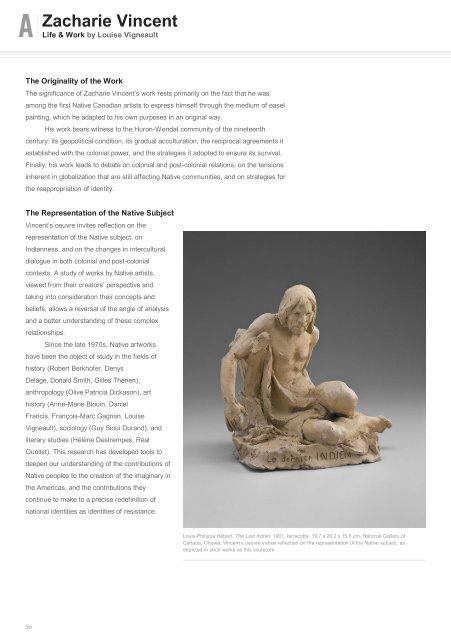Zacharie Vincent
Art-Canada-Institute_Zacharie-Vincent
Art-Canada-Institute_Zacharie-Vincent
- No tags were found...
Create successful ePaper yourself
Turn your PDF publications into a flip-book with our unique Google optimized e-Paper software.
<strong>Zacharie</strong> <strong>Vincent</strong><br />
Life & Work by Louise Vigneault<br />
The Originality of the Work<br />
The significance of <strong>Zacharie</strong> <strong>Vincent</strong>’s work rests primarily on the fact that he was<br />
among the first Native Canadian artists to express himself through the medium of easel<br />
painting, which he adapted to his own purposes in an original way.<br />
His work bears witness to the Huron-Wendat community of the nineteenth<br />
century: its geopolitical condition, its gradual acculturation, the reciprocal agreements it<br />
established with the colonial power, and the strategies it adopted to ensure its survival.<br />
Finally, his work leads to debate on colonial and post-colonial relations, on the tensions<br />
inherent in globalization that are still affecting Native communities, and on strategies for<br />
the reappropriation of identity.<br />
The Representation of the Native Subject<br />
<strong>Vincent</strong>’s oeuvre invites reflection on the<br />
representation of the Native subject, on<br />
Indianness, and on the changes in intercultural<br />
dialogue in both colonial and post-colonial<br />
contexts. A study of works by Native artists,<br />
viewed from their creators’ perspective and<br />
taking into consideration their concepts and<br />
beliefs, allows a reversal of the angle of analysis<br />
and a better understanding of these complex<br />
relationships.<br />
Since the late 1970s, Native artworks<br />
have been the object of study in the fields of<br />
history (Robert Berkhofer, Denys<br />
Delâge, Donald Smith, Gilles Thérien),<br />
anthropology (Olive Patricia Dickason), art<br />
history (Anne-Marie Blouin, Daniel<br />
Francis, François-Marc Gagnon, Louise<br />
Vigneault), sociology (Guy Sioui Durand), and<br />
literary studies (Hélène Destrempes, Réal<br />
Ouellet). This research has developed tools to<br />
deepen our understanding of the contributions of<br />
Native peoples to the creation of the imaginary in<br />
the Americas, and the contributions they<br />
continue to make to a precise redefinition of<br />
national identities as identities of resistance.<br />
Louis-Philippe Hébert, The Last Indian, 1901, terracotta, 19.7 x 20.2 x 15.6 cm, National Gallery of<br />
Canada, Ottawa. <strong>Vincent</strong>’s oeuvre invites reflection on the representation of the Native subject, as<br />
depicted in such works as this sculpture<br />
39


